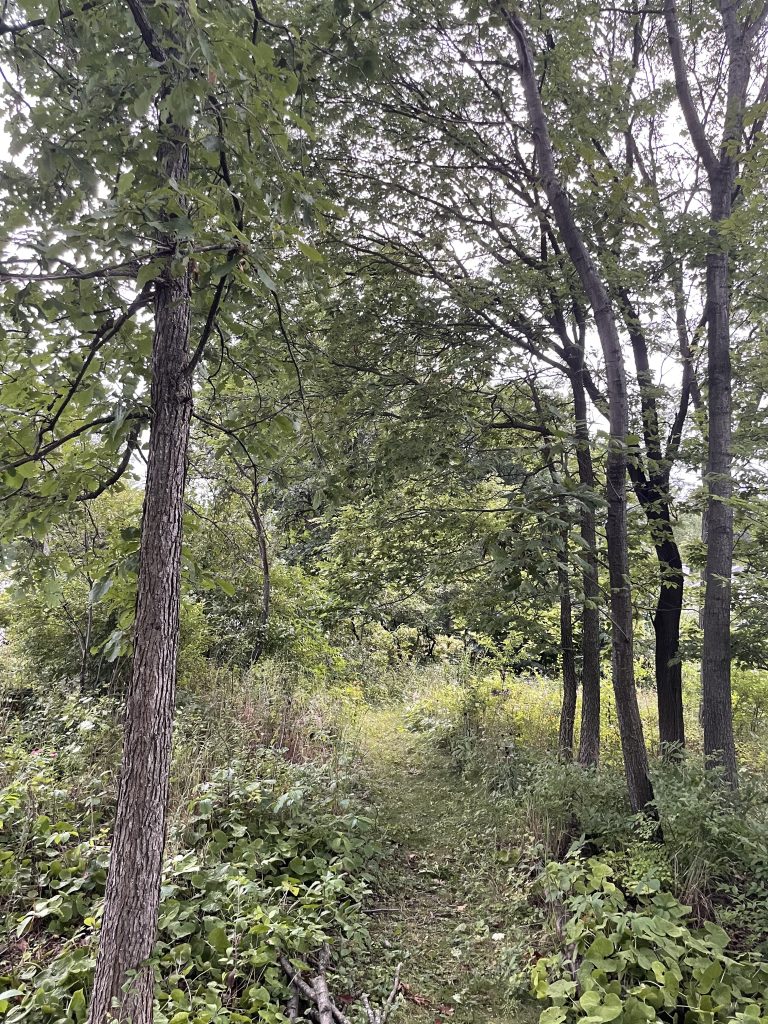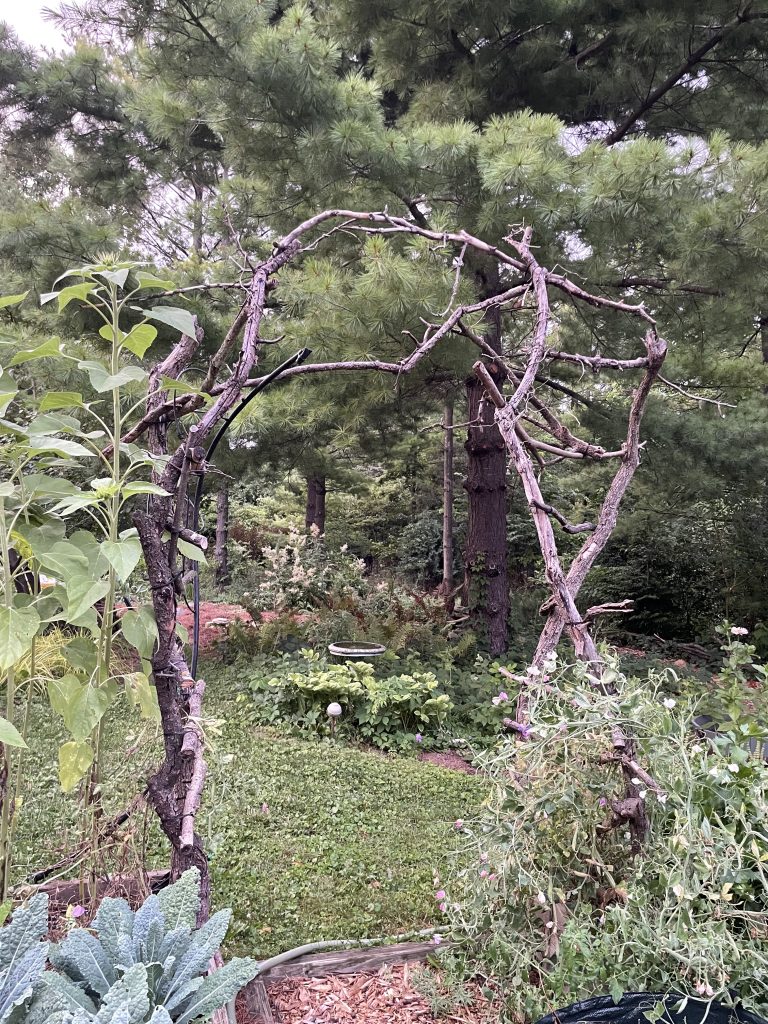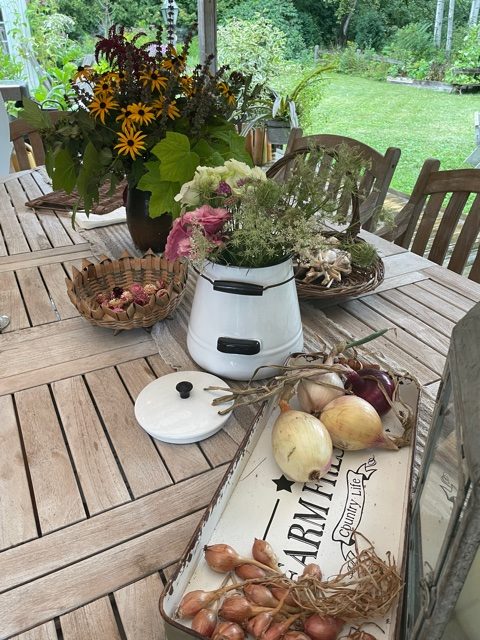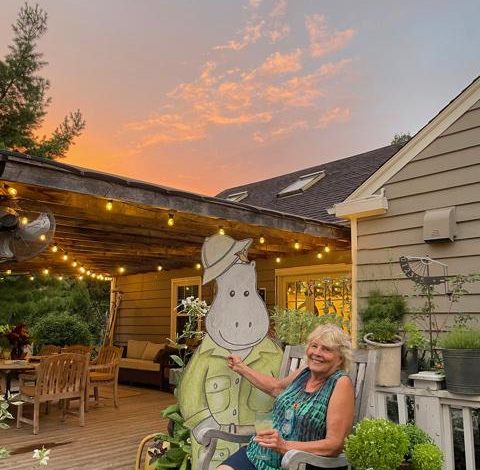
By Hippo (a hippopotamus) and Al (a bird)
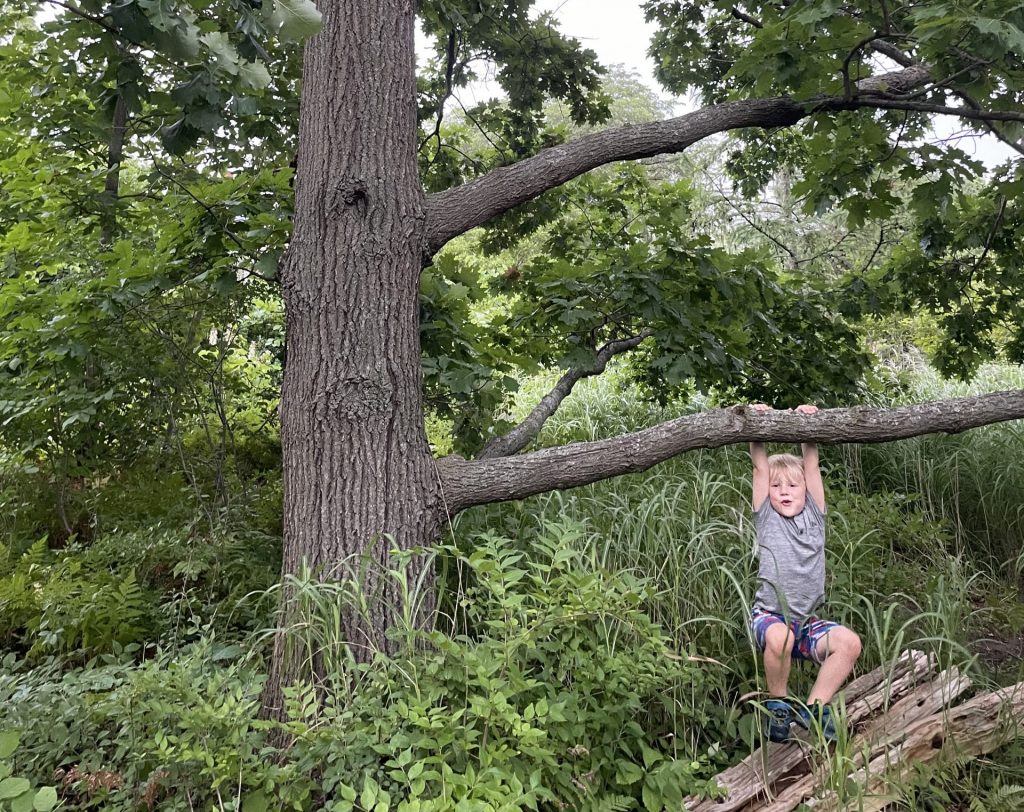
Flowers and peas and real bees’ knees
Booker swinging through the trees
Houses for fairees, plums on the trees
Oh, ouch! I got stuck by a berry
Thorn!
“I couldn’t quite figure out the rhyming on that last part,” said Al.
“That’s OK , Al. I quite like it. ”
Al’s beak turned a bit more red.
Al wrote this poem to commemorate a memorable experience. Here’s the story:
Some time last year, or maybe the year before, we heard about the lady with the wonderful garden who lives across the street from our friend Michael. For a long time, we referred to her as “the lady across the street.” From what we could see of her yard from the street, we just had a feeling that this was a special human. We wanted to meet her, but Michael told us she was out of town. We waited and waited and waited for her return. From time to time we walked past her house.
There was a little evergreen tree in a pot out front. At first it looked cheerful and strong, but after some time, it drooped sadly. Then it fell over and stayed there. One day, it was gone. That was our sign that “the lady across the street” might have returned home.
“The lady across the street” turned out to be Kristin. Last evening we toured her yard with our neighborhood group “Eating Neighborly.”
We went to Kristin’s house with our friends Ashleigh and Booker. Booker is 3 3/4 years old. He wondered if Kristin would have any toys for him to play with. As it turned out, Kristin’s yard was pretty exciting even without toys.
Not long after we arrived, we heard Booker shout, “Come on! You’ve got to see this!” We all came running. It was a bee hive and the bees were “bearding.”
“That’s when they form a furry-looking cluster on the outside of the hive that looks like a beard, ” said Al. “They do it to cool down the hive when the bees are working their hardest. Sometimes they use their wings as fans.”
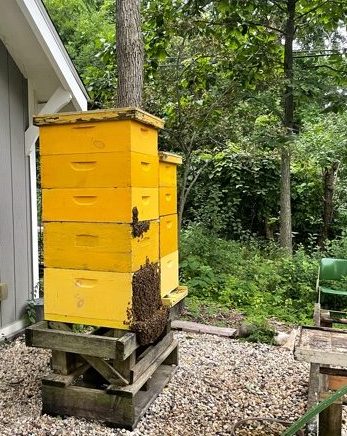
Bees bearding! 
“And a fairy house!” exclaimed Al.
Kristin’s yard is a rarity in its sedate suburban setting. Instead of a large weed-free lawn with a few ornamentals like all the others, Kristin has a very small grassy area. Golden, pink, and purple wild plums, both beautiful and delicious (as this hippo knows), grow in a thicket next to prairie coneflowers, Culver’s root, Joe-Pye weed, and turtlehead. Downy woodpeckers go up and down the seed heads of plants by the driveway, eating the seeds.
Fences and trellises made from the branches and twigs of trees hold flowering vines, watermelon, and squash peaking out from between leaves. And it’s not just beautiful. Animals find shelter, materials for their nests, and a place to bring up their young. One year, a fox couple raised five kits in this yard.
Humans today might not directly need the wild spaces for food, shelter, and building materials, but they do need them just the same. “In our bones we need the natural curves of hills, the scent of chapparal, the whisper of pines, the possibility of wildness. We require these patches of nature for our mental health and our spiritual resilience.”
― Richard Louv, Last Child in the Woods
When Kristin moved in 40 years ago, it was just like all the other yards – all grass. Focusing on native plants, she got to work planting redbud trees and pawpaw, native honeysuckle, and tamarack. The tamarack is the only conifer in Wisconsin that changes color (to a beautiful golden) and drops its leaves in the fall. Food for many, sweet fragrances, interesting colors and textures – Kristin fills her yard with beauty.
“I grew up on the savanna, so that’s the best place for me,” said Al, “but but Kristin’s yard is good for my relatives from this part of the world. Because of the diversity of native plants, there are plenty of berries, caterpillars, crickets, beetles, moths and spiders to eat, lots of holes to raise babies, and twigs and soft materials to build nests.”
Humans like to share their yards with pretty birds. They even buy seeds and hang feeders for them, but here’s something you may not know if you’re not a bird: Even though many adult birds like nectar, seeds and berries, most of our babies require insects like caterpillars and other larvae for their growth. And, believe me, growing babies need a lot of food.
Like baby birds, adults require protein and fats for muscle tone and energy and will take an insect over seeds or fruit almost every time. Insects are so important in bird diets that when cold weather decreases insect abundance, 350 species (or 54 percent) of the birds that breed in North America undertake the most dangerous adventure of their lives, migration, to move to areas where insects remain abundant during the winter.
Doug Tallamy
“Do you see what this means, Hippo?”
Al did not wait for me to reply.
“It means,” said Al, “that birds need butterflies, moths, and other insects to carry on their species. Everybody knows that the monarch caterpillars need milkweed, but did you know that most leaf-eating insects are not able to eat non-native plants? Fewer native trees, shrubs and flowers means fewer insects.
“That makes sense, because they co-evolved over millions of years.”
The Miracle
Just like I said in Chapter 4 of The True Adventures of Hippo and Al, “All the pieces fit together perfectly.”
“But when many of the natives are absent from the ecosystem and non-natives have taken their place,” I said, “it’s like trying to put together a jigsaw puzzle with many pieces missing and random pieces thrown in from different puzzles. You can try to jam the pieces together, but they don’t really fit any more. The ecosystem gradually loses vitality.
“Did you know that there are places where pollination is done by human hand because there aren’t enough natural pollinators to do the job?” squawked Al. “What a lot of work!”
Most humans don’t understand that their sterile yards are pushing fellow earthlings out of their homes.
“Not to mention making more work for themselves!” exclaimed Al.
A wild hippo can’t live in a human yard – no way! But given the chance, many non-humans could. With more and more roads, parking lots, strip malls, etc., increasingly there is nowhere else to turn. National parks and protected lands are not enough. Al and I support the idea presented by Doug Tallamy – “Homegrown National Park.” The idea is to transform half of the estimated 40 million acres of lawn space into habitat good for humans and non-humans alike – to create millions of small national parks. Our friend Kristin’s yard would be united with many others across the country, creating a web of habitat that provides food and shelter for a great diversity of life forms.
“Just imagine all the birds,” said Al.
As Tallamy says in his book, Bringing Nature Home, this can be accomplished without government action, “by untrained citizens with minimal expense and without any costly changes to infrastructure.”
Al and I love humans. We have met so many fine members of this species, both in person and through their books. We can’t even imagine life without them. Some of their inventions (like potluck dinners and sailing) are superb. Others are clearly not well thought out. Large, monocrop lawns of alien grass species, requiring pesticides to maintain, along with foreign ornamental plants belong with the second group.
This is a call to action. Please invite some native plants into your yard.


